🍨 本文为[🔗365天深度学习训练营]内部限免文章(版权归 K同学啊 所有)
🍖 作者:[K同学啊]
📌 本周任务:
1.了解并学习InceptionV3相对于InceptionV1改进了哪些地方(重点)
2.使用Inception v3完成天气识别案例
一、理论基础
Inception v3由谷歌研究员Christian Szegedy等人在2015年的论文《Rethinking the Inception Architecture for Computer Vision》中提出。Inception v3是Inception网络系列的第三个版本,它在ImageNet图像识别竞赛中取得了优异成绩,尤其是在大规模图像识别任务中表现出色。
Inception v3的主要特点如下:
1更深的网络结构:Inception v3比之前的Inception网络结构更深,包含了48层卷积层。这使得网络可以提取更多层次的特征,从而在图像识别任务上取得更好的效果。
2使用Factorized Convolutions:Inception v3采用了Factorized Convolutions(分解卷积),将较大的卷积核分解为多个较小的卷积核。这种方法可以降低网络的参数数量,减少计算复杂度,同时保持良好的性能。
3使用Batch Normalization:Inception v3在每个卷积层之后都添加了Batch Normalization(BN),这有助于网络的收敛和泛化能力。BN可以减少Internal Covariate Shift(内部协变量偏移)现象,加快训练速度,同时提高模型的鲁棒性。
4辅助分类器:Inception v3引入了辅助分类器,可以在网络训练过程中提供额外的梯度信息,帮助网络更好地学习特征。辅助分类器位于网络的某个中间层,其输出会与主分类器的输出进行加权融合,从而得到最终的预测结果。
5基于RMSProp的优化器:Inception v3使用了RMSProp优化器进行训练。相比于传统的随机梯度下降(SGD)方法,RMSProp可以自适应地调整学习率,使得训练过程更加稳定,收敛速度更快。
Inception v3在图像分类、物体检测和图像分割等计算机视觉任务中均取得了显著的效果。然而,由于其较大的网络结构和计算复杂度,Inception v3在实际应用中可能需要较高的硬件要求。
相对于Inception v1的Inception Module结构,Inception v3中做出了如下改动:
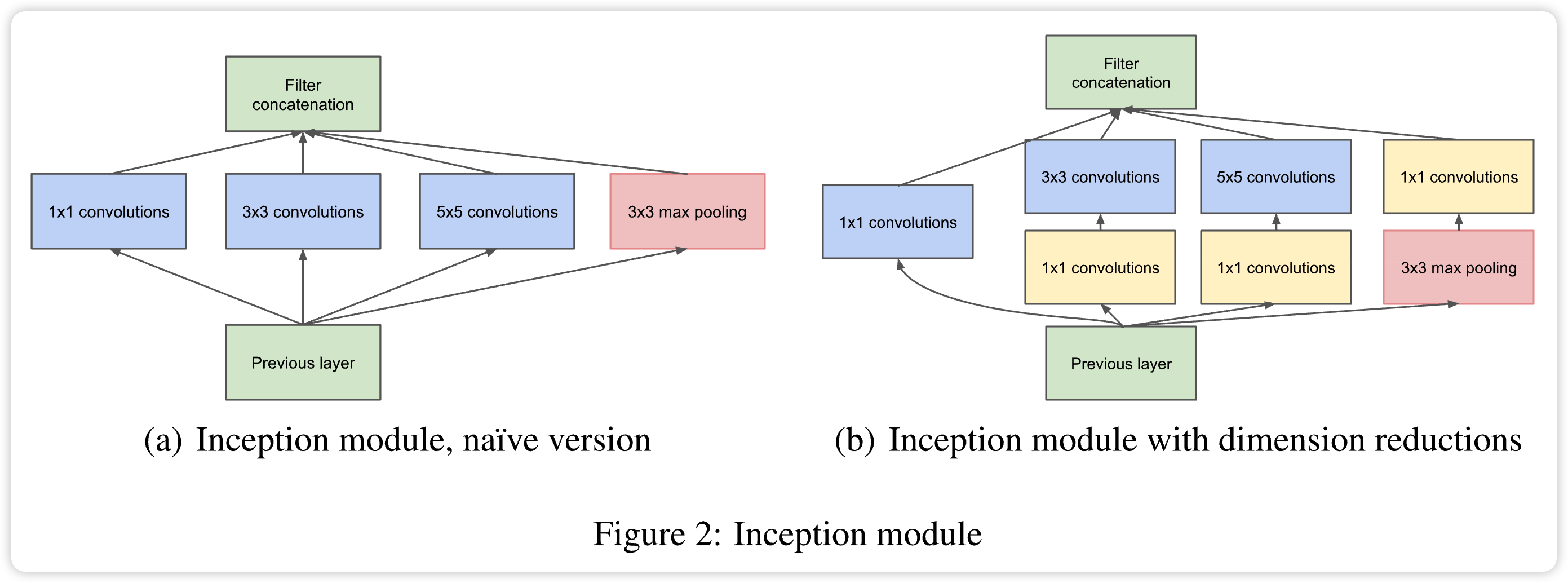
将 5×5 的卷积分解为两个 3×3 的卷积运算以提升计算速度。尽管这有点违反直觉,但一个 5×5 的卷积在计算成本上是一个 3×3 卷积的 2.78 倍。所以叠加两个 3×3 卷积实际上在性能上会有所提升,如下图所示:
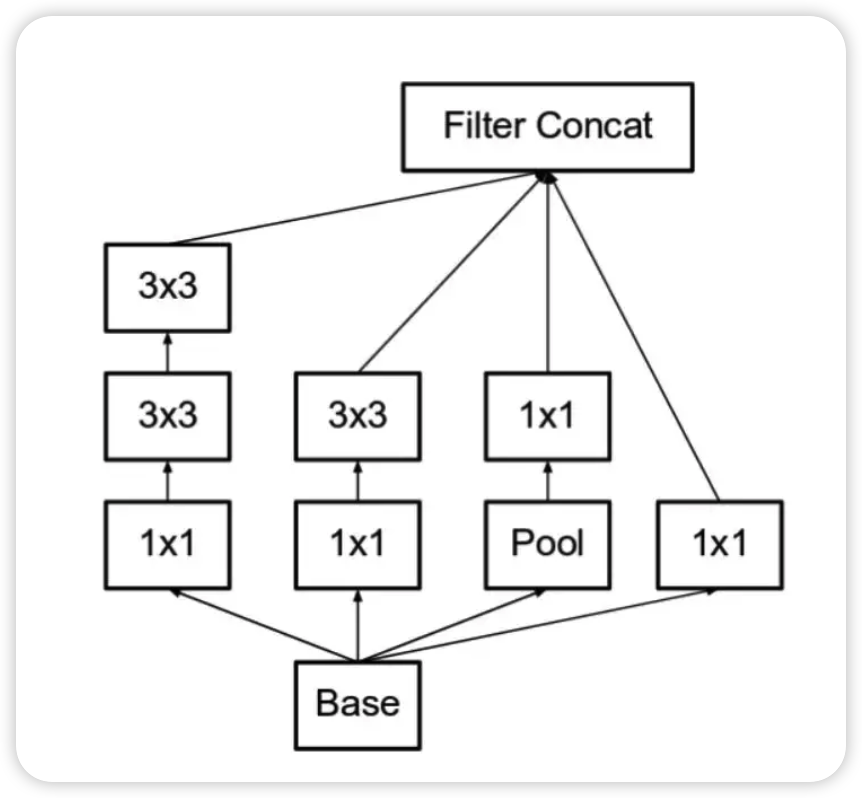
此外,作者将 n×n 的卷积核尺寸分解为 1×n 和 n×1 两个卷积。例如,一个 3×3 的卷积等价于首先执行一个 1×3 的卷积再执行一个 3×1 的卷积。他们还发现这种方法在成本上要比单个 3×3 的卷积降低 33%,这一结构如下图所示:

此处如果 n=3,则与上一张图像一致。最左侧的 5x5 卷积可被表示为两个 3x3 卷积,它们又可以被表示为 1x3 和 3x1 卷积。
模块中的滤波器组被扩展(即变得更宽而不是更深),以解决表征性瓶颈。如果该模块没有被拓展宽度,而是变得更深,那么维度会过多减少,造成信息损失。如下图所示:

最后实现的inception v3网络是上图结构图如下:
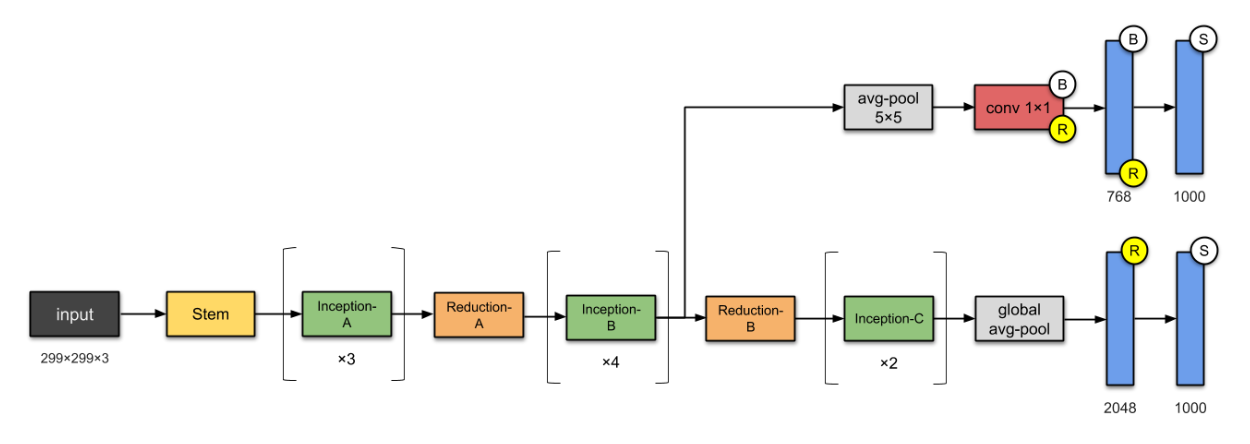
二、pytorch代码复现
1.前期准备
大致模板和以前一样,以后不再详细列,样例可见:深度学习第J4周:ResNet与DenseNet结合探索_牛大了2023的博客-CSDN博客
配置gpu+导入数据集
import os,PIL,random,pathlib
import torch
import torch.nn as nn
import torchvision.transforms as transforms
import torchvision
from torchvision import transforms, datasets
device = torch.device("cuda" if torch.cuda.is_available() else "cpu")
print(device)
data_dir = './data/'
data_dir = pathlib.Path(data_dir)
data_paths = list(data_dir.glob('*'))
classeNames = [str(path).split("\\")[1] for path in data_paths]
print(classeNames)
image_count = len(list(data_dir.glob('*/*')))
print("图片总数为:", image_count)
数据预处理+划分数据集
train_transforms = transforms.Compose([
transforms.Resize([224, 224]), # 将输入图片resize成统一尺寸
# transforms.RandomHorizontalFlip(), # 随机水平翻转
transforms.ToTensor(), # 将PIL Image或numpy.ndarray转换为tensor,并归一化到[0,1]之间
transforms.Normalize( # 标准化处理-->转换为标准正太分布(高斯分布),使模型更容易收敛
mean=[0.485, 0.456, 0.406],
std=[0.229, 0.224, 0.225]) # 其中 mean=[0.485,0.456,0.406]与std=[0.229,0.224,0.225] 从数据集中随机抽样计算得到的。
])
test_transform = transforms.Compose([
transforms.Resize([224, 224]), # 将输入图片resize成统一尺寸
transforms.ToTensor(), # 将PIL Image或numpy.ndarray转换为tensor,并归一化到[0,1]之间
transforms.Normalize( # 标准化处理-->转换为标准正太分布(高斯分布),使模型更容易收敛
mean=[0.485, 0.456, 0.406],
std=[0.229, 0.224, 0.225]) # 其中 mean=[0.485,0.456,0.406]与std=[0.229,0.224,0.225] 从数据集中随机抽样计算得到的。
])
total_data = datasets.ImageFolder("./data/", transform=train_transforms)
print(total_data.class_to_idx)
train_size = int(0.8 * len(total_data))
test_size = len(total_data) - train_size
train_dataset, test_dataset = torch.utils.data.random_split(total_data, [train_size, test_size])
batch_size = 32
train_dl = torch.utils.data.DataLoader(train_dataset,
batch_size=batch_size,
shuffle=True,
num_workers=0)
test_dl = torch.utils.data.DataLoader(test_dataset,
batch_size=batch_size,
shuffle=True,
num_workers=0)
for X, y in test_dl:
print("Shape of X [N, C, H, W]: ", X.shape)
print("Shape of y: ", y.shape, y.dtype)
break

2.代码复现
class BasicConv2d(nn.Module):
def __init__(self, in_channel, out_channel, **kwargs):
super(BasicConv2d, self).__init__()
self.conv = nn.Conv2d(in_channel, out_channel, bias=False, **kwargs)
self.norm = nn.BatchNorm2d(out_channel, eps=0.001)
self.relu = nn.ReLU(inplace=True)
def forward(self, x):
x = self.conv(x)
x = self.norm(x)
x = self.relu(x)
return x
class InceptionA(nn.Module):
def __init__(self, in_channels, pool_features):
super(InceptionA, self).__init__()
self.branch1x1 = BasicConv2d(in_channels, 64, kernel_size=1) # 1
self.branch5x5_1 = BasicConv2d(in_channels, 48, kernel_size=1)
self.branch5x5_2 = BasicConv2d(48, 64, kernel_size=5, padding=2)
self.branch3x3dbl_1 = BasicConv2d(in_channels, 64, kernel_size=1)
self.branch3x3dbl_2 = BasicConv2d(64, 96, kernel_size=3, padding=1)
self.branch3x3dbl_3 = BasicConv2d(96, 96, kernel_size=3, padding=1)
self.branch_pool = BasicConv2d(in_channels, pool_features, kernel_size=1)
def forward(self, x):
branch1x1 = self.branch1x1(x)
branch5x5 = self.branch5x5_1(x)
branch5x5 = self.branch5x5_2(branch5x5)
branch3x3dbl = self.branch3x3dbl_1(x)
branch3x3dbl = self.branch3x3dbl_2(branch3x3dbl)
branch3x3dbl = self.branch3x3dbl_3(branch3x3dbl)
branch_pool = F.avg_pool2d(x, kernel_size=3, stride=1, padding=1)
branch_pool = self.branch_pool(branch_pool)
outputs = [branch1x1, branch5x5, branch3x3dbl, branch_pool]
return torch.cat(outputs, 1)
class InceptionB(nn.Module):
def __init__(self, in_channels, channels_7x7):
super(InceptionB, self).__init__()
self.branch1x1 = BasicConv2d(in_channels, 192, kernel_size=1)
c7 = channels_7x7
self.branch7x7_1 = BasicConv2d(in_channels, c7, kernel_size=1)
self.branch7x7_2 = BasicConv2d(c7, c7, kernel_size=(1, 7), padding=(0, 3))
self.branch7x7_3 = BasicConv2d(c7, 192, kernel_size=(7, 1), padding=(3, 0))
self.branch7x7dbl_1 = BasicConv2d(in_channels, c7, kernel_size=1)
self.branch7x7dbl_2 = BasicConv2d(c7, c7, kernel_size=(7, 1), padding=(3, 0))
self.branch7x7dbl_3 = BasicConv2d(c7, c7, kernel_size=(1, 7), padding=(0, 3))
self.branch7x7dbl_4 = BasicConv2d(c7, c7, kernel_size=(7, 1), padding=(3, 0))
self.branch7x7dbl_5 = BasicConv2d(c7, 192, kernel_size=(1, 7), padding=(0, 3))
self.branch_pool = BasicConv2d(in_channels, 192, kernel_size=1)
def forward(self, x):
branch1x1 = self.branch1x1(x)
branch7x7 = self.branch7x7_1(x)
branch7x7 = self.branch7x7_2(branch7x7)
branch7x7 = self.branch7x7_3(branch7x7)
branch7x7dbl = self.branch7x7dbl_1(x)
branch7x7dbl = self.branch7x7dbl_2(branch7x7dbl)
branch7x7dbl = self.branch7x7dbl_3(branch7x7dbl)
branch7x7dbl = self.branch7x7dbl_4(branch7x7dbl)
branch7x7dbl = self.branch7x7dbl_5(branch7x7dbl)
branch_pool = F.avg_pool2d(x, kernel_size=3, stride=1, padding=1)
branch_pool = self.branch_pool(branch_pool)
outputs = [branch1x1, branch7x7, branch7x7dbl, branch_pool]
return torch.cat(outputs, 1)
class InceptionC(nn.Module):
def __init__(self, in_channels):
super(InceptionC, self).__init__()
self.branch1x1 = BasicConv2d(in_channels, 320, kernel_size=1)
self.branch3x3_1 = BasicConv2d(in_channels, 384, kernel_size=1)
self.branch3x3_2a = BasicConv2d(384, 384, kernel_size=(1, 3), padding=(0, 1))
self.branch3x3_2b = BasicConv2d(384, 384, kernel_size=(3, 1), padding=(1, 0))
self.branch3x3dbl_1 = BasicConv2d(in_channels, 448, kernel_size=1)
self.branch3x3dbl_2 = BasicConv2d(448, 384, kernel_size=3, padding=1)
self.branch3x3dbl_3a = BasicConv2d(384, 384, kernel_size=(1, 3), padding=(0, 1))
self.branch3x3dbl_3b = BasicConv2d(384, 384, kernel_size=(3, 1), padding=(1, 0))
self.branch_pool = BasicConv2d(in_channels, 192, kernel_size=1)
def forward(self, x):
branch1x1 = self.branch1x1(x)
branch3x3 = self.branch3x3_1(x)
branch3x3 = [
self.branch3x3_2a(branch3x3),
self.branch3x3_2b(branch3x3),
]
branch3x3 = torch.cat(branch3x3, 1)
branch3x3dbl = self.branch3x3dbl_1(x)
branch3x3dbl = self.branch3x3dbl_2(branch3x3dbl)
branch3x3dbl = [
self.branch3x3dbl_3a(branch3x3dbl),
self.branch3x3dbl_3b(branch3x3dbl),
]
branch3x3dbl = torch.cat(branch3x3dbl, 1)
branch_pool = F.avg_pool2d(x, kernel_size=3, stride=1, padding=1)
branch_pool = self.branch_pool(branch_pool)
outputs = [branch1x1, branch3x3, branch3x3dbl, branch_pool]
return torch.cat(outputs, 1)
class ReductionA(nn.Module):
def __init__(self, in_channels):
super(ReductionA, self).__init__()
self.branch3x3 = BasicConv2d(in_channels, 384, kernel_size=3, stride=2)
self.branch3x3dbl_1 = BasicConv2d(in_channels, 64, kernel_size=1)
self.branch3x3dbl_2 = BasicConv2d(64, 96, kernel_size=3, padding=1)
self.branch3x3dbl_3 = BasicConv2d(96, 96, kernel_size=3, stride=2)
def forward(self, x):
branch3x3 = self.branch3x3(x)
branch3x3dbl = self.branch3x3dbl_1(x)
branch3x3dbl = self.branch3x3dbl_2(branch3x3dbl)
branch3x3dbl = self.branch3x3dbl_3(branch3x3dbl)
branch_pool = F.max_pool2d(x, kernel_size=3, stride=2)
outputs = [branch3x3, branch3x3dbl, branch_pool]
return torch.cat(outputs, 1)
class ReductionB(nn.Module):
def __init__(self, in_channels):
super(ReductionB, self).__init__()
self.branch3x3_1 = BasicConv2d(in_channels, 192, kernel_size=1)
self.branch3x3_2 = BasicConv2d(192, 320, kernel_size=3, stride=2)
self.branch7x7x3_1 = BasicConv2d(in_channels, 192, kernel_size=1)
self.branch7x7x3_2 = BasicConv2d(192, 192, kernel_size=(1, 7), padding=(0, 3))
self.branch7x7x3_3 = BasicConv2d(192, 192, kernel_size=(7, 1), padding=(3, 0))
self.branch7x7x3_4 = BasicConv2d(192, 192, kernel_size=3, stride=2)
def forward(self, x):
branch3x3 = self.branch3x3_1(x)
branch3x3 = self.branch3x3_2(branch3x3)
branch7x7x3 = self.branch7x7x3_1(x)
branch7x7x3 = self.branch7x7x3_2(branch7x7x3)
branch7x7x3 = self.branch7x7x3_3(branch7x7x3)
branch7x7x3 = self.branch7x7x3_4(branch7x7x3)
branch_pool = F.max_pool2d(x, kernel_size=3, stride=2)
outputs = [branch3x3, branch7x7x3, branch_pool]
return torch.cat(outputs, 1)
class InceptionAux(nn.Module):
def __init__(self, in_channels, num_classes):
super(InceptionAux, self).__init__()
self.conv0 = BasicConv2d(in_channels, 128, kernel_size=1)
self.conv1 = BasicConv2d(128, 768, kernel_size=5)
self.conv1.stddev = 0.01
self.fc = nn.Linear(768, num_classes)
self.fc.stddev = 0.001
def forward(self, x):
# 17 x 17 x 768
x = F.avg_pool2d(x, kernel_size=5, stride=3)
# 5 x 5 x 768
x = self.conv0(x)
# 5 x 5 x 128
x = self.conv1(x)
# 1 x 1 x 768
x = x.view(x.size(0), -1)
# 768
x = self.fc(x)
# 1000
return x
import torch.nn.functional as F
class InceptionV3(nn.Module):
def __init__(self, num_classes=1000, aux_logits=False, transform_input=False):
super(InceptionV3, self).__init__()
self.aux_logits = aux_logits
self.transform_input = transform_input
self.Conv2d_1a_3x3 = BasicConv2d(3, 32, kernel_size=3, stride=2)
self.Conv2d_2a_3x3 = BasicConv2d(32, 32, kernel_size=3)
self.Conv2d_2b_3x3 = BasicConv2d(32, 64, kernel_size=3, padding=1)
self.Conv2d_3b_1x1 = BasicConv2d(64, 80, kernel_size=1)
self.Conv2d_4a_3x3 = BasicConv2d(80, 192, kernel_size=3)
self.Mixed_5b = InceptionA(192, pool_features=32)
self.Mixed_5c = InceptionA(256, pool_features=64)
self.Mixed_5d = InceptionA(288, pool_features=64)
self.Mixed_6a = ReductionA(288)
self.Mixed_6b = InceptionB(768, channels_7x7=128)
self.Mixed_6c = InceptionB(768, channels_7x7=160)
self.Mixed_6d = InceptionB(768, channels_7x7=160)
self.Mixed_6e = InceptionB(768, channels_7x7=192)
if aux_logits:
self.AuxLogits = InceptionAux(768, num_classes)
self.Mixed_7a = ReductionB(768)
self.Mixed_7b = InceptionC(1280)
self.Mixed_7c = InceptionC(2048)
self.fc = nn.Linear(2048, num_classes)
def forward(self, x):
if self.transform_input: # 1
x = x.clone()
x[:, 0] = x[:, 0] * (0.229 / 0.5) + (0.485 - 0.5) / 0.5
x[:, 1] = x[:, 1] * (0.224 / 0.5) + (0.456 - 0.5) / 0.5
x[:, 2] = x[:, 2] * (0.225 / 0.5) + (0.406 - 0.5) / 0.5
# 299 x 299 x 3
x = self.Conv2d_1a_3x3(x)
# 149 x 149 x 32
x = self.Conv2d_2a_3x3(x)
# 147 x 147 x 32
x = self.Conv2d_2b_3x3(x)
# 147 x 147 x 64
x = F.max_pool2d(x, kernel_size=3, stride=2)
# 73 x 73 x 64
x = self.Conv2d_3b_1x1(x)
# 73 x 73 x 80
x = self.Conv2d_4a_3x3(x)
# 71 x 71 x 192
x = F.max_pool2d(x, kernel_size=3, stride=2)
# 35 x 35 x 192
x = self.Mixed_5b(x)
# 35 x 35 x 256
x = self.Mixed_5c(x)
# 35 x 35 x 288
x = self.Mixed_5d(x)
# 35 x 35 x 288
x = self.Mixed_6a(x)
# 17 x 17 x 768
x = self.Mixed_6b(x)
# 17 x 17 x 768
x = self.Mixed_6c(x)
# 17 x 17 x 768
x = self.Mixed_6d(x)
# 17 x 17 x 768
x = self.Mixed_6e(x)
# 17 x 17 x 768
if self.training and self.aux_logits:
aux = self.AuxLogits(x)
# 17 x 17 x 768
x = self.Mixed_7a(x)
# 8 x 8 x 1280
x = self.Mixed_7b(x)
# 8 x 8 x 2048
x = self.Mixed_7c(x)
# 8 x 8 x 2048
x = F.avg_pool2d(x, kernel_size=5)
# 1 x 1 x 2048
x = F.dropout(x, training=self.training)
# 1 x 1 x 2048
x = x.view(x.size(0), -1)
# 2048
x = self.fc(x)
# 1000 (num_classes)
if self.training and self.aux_logits:
return x, aux
return x
可以打印查看一下
# 统计模型参数量以及其他指标
import torchsummary
# 调用并将模型转移到GPU中
model = InceptionV3().to(device)
# 显示网络结构
torchsummary.summary(model, (3, 299, 299))
print(model)
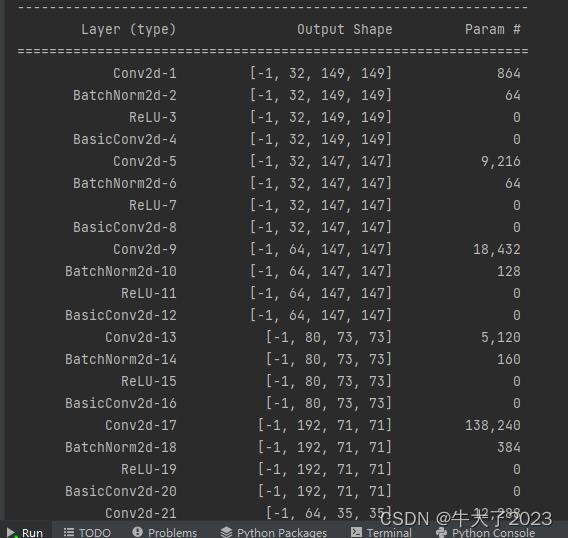
3.训练运行
代码和以前的差不多,不再细说
# 训练循环
def train(dataloader, model, loss_fn, optimizer):
size = len(dataloader.dataset) # 训练集的大小
num_batches = len(dataloader) # 批次数目, (size/batch_size,向上取整)
train_loss, train_acc = 0, 0 # 初始化训练损失和正确率
for X, y in dataloader: # 获取图片及其标签
X, y = X.to(device), y.to(device)
# 计算预测误差
pred = model(X) # 网络输出
loss = loss_fn(pred, y) # 计算网络输出和真实值之间的差距,targets为真实值,计算二者差值即为损失
# 反向传播
optimizer.zero_grad() # grad属性归零
loss.backward() # 反向传播
optimizer.step() # 每一步自动更新
# 记录acc与loss
train_acc += (pred.argmax(1) == y).type(torch.float).sum().item()
train_loss += loss.item()
train_acc /= size
train_loss /= num_batches
return train_acc, train_loss
def test(dataloader, model, loss_fn):
size = len(dataloader.dataset) # 测试集的大小
num_batches = len(dataloader) # 批次数目
test_loss, test_acc = 0, 0
# 当不进行训练时,停止梯度更新,节省计算内存消耗
with torch.no_grad():
for imgs, target in dataloader:
imgs, target = imgs.to(device), target.to(device)
# 计算loss
target_pred = model(imgs)
loss = loss_fn(target_pred, target)
test_loss += loss.item()
test_acc += (target_pred.argmax(1) == target).type(torch.float).sum().item()
test_acc /= size
test_loss /= num_batches
return test_acc, test_loss
跑十轮并保存模型
import copy
optimizer = torch.optim.Adam(model.parameters(), lr=1e-4)
loss_fn = nn.CrossEntropyLoss() # 创建损失函数
epochs = 10
train_loss = []
train_acc = []
test_loss = []
test_acc = []
best_acc = 0 # 设置一个最佳准确率,作为最佳模型的判别指标
for epoch in range(epochs):
# 更新学习率(使用自定义学习率时使用)
# adjust_learning_rate(optimizer, epoch, learn_rate)
model.train()
epoch_train_acc, epoch_train_loss = train(train_dl, model, loss_fn, optimizer)
# scheduler.step() # 更新学习率(调用官方动态学习率接口时使用)
model.eval()
epoch_test_acc, epoch_test_loss = test(test_dl, model, loss_fn)
# 保存最佳模型到 best_model
if epoch_test_acc > best_acc:
best_acc = epoch_test_acc
best_model = copy.deepcopy(model)
train_acc.append(epoch_train_acc)
train_loss.append(epoch_train_loss)
test_acc.append(epoch_test_acc)
test_loss.append(epoch_test_loss)
# 获取当前的学习率
lr = optimizer.state_dict()['param_groups'][0]['lr']
template = ('Epoch:{:2d}, Train_acc:{:.1f}%, Train_loss:{:.3f}, Test_acc:{:.1f}%, Test_loss:{:.3f}, Lr:{:.2E}')
print(template.format(epoch + 1, epoch_train_acc * 100, epoch_train_loss,
epoch_test_acc * 100, epoch_test_loss, lr))
# 保存最佳模型到文件中
PATH = './best_model.pth' # 保存的参数文件名
torch.save(model.state_dict(), PATH)
print('Done')
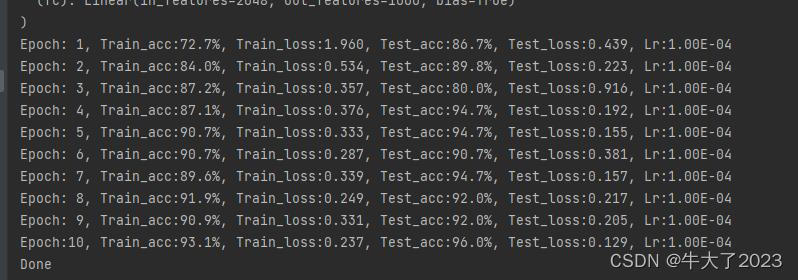
打印训练记录图
import matplotlib.pyplot as plt
# 隐藏警告
import warnings
warnings.filterwarnings("ignore") # 忽略警告信息
plt.rcParams['font.sans-serif'] = ['SimHei'] # 用来正常显示中文标签
plt.rcParams['axes.unicode_minus'] = False # 用来正常显示负号
plt.rcParams['figure.dpi'] = 100 # 分辨率
epochs_range = range(epochs)
plt.figure(figsize=(12, 3))
plt.subplot(1, 2, 1)
plt.plot(epochs_range, train_acc, label='Training Accuracy')
plt.plot(epochs_range, test_acc, label='Test Accuracy')
plt.legend(loc='lower right')
plt.title('Training and Validation Accuracy')
plt.subplot(1, 2, 2)
plt.plot(epochs_range, train_loss, label='Training Loss')
plt.plot(epochs_range, test_loss, label='Test Loss')
plt.legend(loc='upper right')
plt.title('Training and Validation Loss')
plt.show()

3.2指定图片进行预测
把训练部分注释掉
from PIL import Image
classes = list(total_data.class_to_idx)
def predict_one_image(image_path, model, transform, classes):
test_img = Image.open(image_path).convert('RGB')
plt.imshow(test_img) # 展示预测的图片
test_img = transform(test_img)
img = test_img.to(device).unsqueeze(0)
model.eval()
output = model(img)
_, pred = torch.max(output, 1)
pred_class = classes[pred]
print(f'预测结果是:{pred_class}')
# 预测训练集中的某张照片
predict_one_image(image_path='./data/cloudy/cloudy16.jpg',
model=model,
transform=train_transforms,
classes=classes)
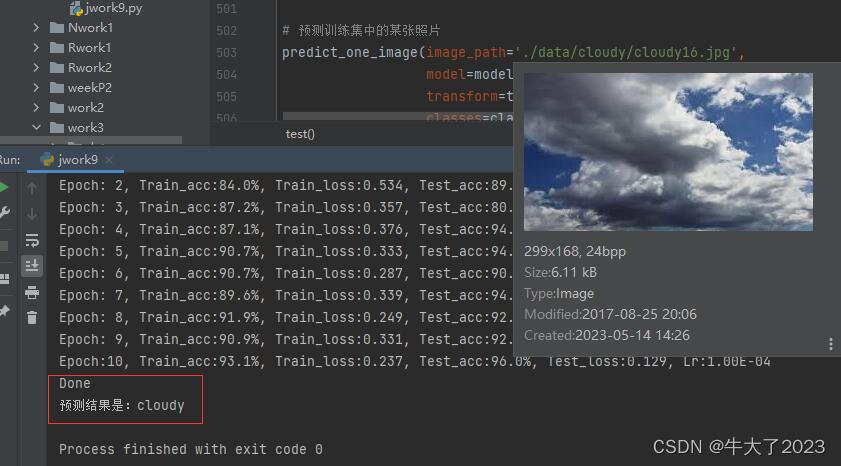
三、总结
总结来说,Inception v3是一种深度卷积神经网络,其主要特点包括更深的网络结构、使用Factorized Convolutions、添加Batch Normalization、引入辅助分类器以及使用基于RMSProp的优化器进行训练。相对于Inception v1的Inception Module结构,Inception v3在卷积操作上做出了改动,使用两个3x3的卷积代替一个5x5的卷积以提高计算速度,并将n x n的卷积核尺寸分解为1 x n和n x 1两个卷积。此外,滤波器组也被扩展以解决表征性瓶颈。在计算机视觉任务中,Inception v3在图像分类、物体检测和图像分割等方面均表现优异。然而,由于其较大的网络结构和计算复杂度,Inception v3在实际应用中可能需要较高的硬件要求。
版权归原作者 牛大了2023 所有, 如有侵权,请联系我们删除。